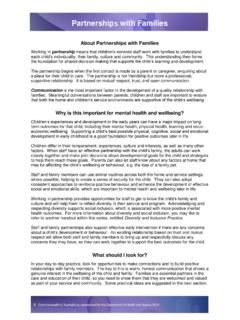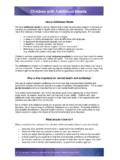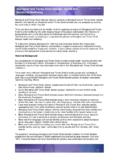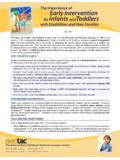Transcription of Identifying Emotional and Behavioural Problems
1 Commonwealth of Australia as represented by the Department of Health and Ageing 2010 About Emotional and Behavioural Problems Most young children display behaviours that would not be socially acceptable in older children , or could cause personal and interpersonal Problems if they persisted into adolescence and adulthood. Examples include tantrums, unfounded fears and overly anxious behaviour, aggressive behaviour such as hitting or biting, disruptive behaviour and defiance. A child s feelings and behaviours are influenced by temperament, culture, relationships, health, tiredness, family circumstances, experiences of early childhood care and education and a range of other factors.
2 Almost all children show difficulties in managing their feelings and behaviour at times, particularly during certain stages of development. Because of this complexity, it can be difficult to determine whether a child s behaviour or feelings may need further assessment. For most children , Emotional or Behavioural Problems like those described above are temporary. They can often be addressed successfully as the child develops further and is provided with guidance and support from family and carers. Developing a close partnership with the family is important, to ensure consistency across the home and service settings.
3 For more information about supporting positive social and Emotional development and guiding behaviour, refer to the handouts in this series: Building Social and Emotional Skills; and Guiding children s Behaviour. Why is this important for mental health and wellbeing? If there are ongoing Emotional or Behavioural Problems in early childhood, there may be an underlying developmental delay or disorder ( an autism spectrum disorder) or a greater risk of some types of mental illness in childhood or later in life ( conduct disorder, depression).
4 Identifying those who may be at greater risk or already have signs of Emotional or Behavioural difficulties allows us to ensure that they can access appropriate intervention services early in life if needed, which is an important strategy to promote positive outcomes for these children . Depending on the situation, the benefits of identification and early intervention could include improved behaviour and developmental outcomes, greater community participation and social inclusion, better academic outcomes and a reduction in the risk or severity of certain types of mental illness or disorder later in childhood, adolescence or adulthood.
5 What should I look for? Issues of concern may be raised either by the child s family or by children s services staff, who will need to work together to compare their observations and to decide if further assessment is needed. Signs of Emotional or Behavioural difficulties in young children could include: Significant changes in feelings or behaviour Behaviour that is out of step with peers at a similar age and stage Persistent separation difficulties or attachment Problems with family Being withdrawn, fearful, anxious or upset much of the time Poor-quality play that seems limited and repetitive Difficulty managing anger and frustration, frequent tantrums or aggression Difficulty in paying attention.
6 Following instructions and completing tasks Frequent defiance and refusal to follow instructions. Identifying Emotional and Behavioural Problems Commonwealth of Australia as represented by the Department of Health and Ageing 2010 Most children have trouble managing their feelings and behaviour at times, particularly at certain stages of development. Many will also show temporary changes in behaviour when they are unwell or tired, or in association with a difficult situation such as grief or loss, or family stress.
7 When trying to decide whether further assessment is needed, it is important that staff and family members compare the child s behaviour and capacity with others at a similar stage of development and take into account any contextual factors that may be affecting the child. A general practitioner (GP) is a good place to start if there are concerns about a child s development or behaviour. He or she can perform an initial assessment and refer the child and family to other professionals if needed for additional assessment, treatment and support.
8 Assessment by a paediatrician, psychiatrist or psychologist would generally be recommended if: The behaviour seems extreme when compared with other children at a similar stage The problem is ongoing and has been observed over several weeks or months The behaviour is not improving despite efforts of adults to guide or support the child It happens across more than one setting ( at home, playgroup, the park, preschool) It is interfering with the child s ongoing development, learning or progress in certain areas, for example there may be concerns about school readiness.
9 What should I do? If you are concerned about a child s emotions or behaviour, think about whether your expectations of the child are developmentally appropriate. If you are still concerned, Observe the child during several different activities, at different times of the day Write down specific examples of the problem or behaviour and when it occurs Write down any additional information about the child s health and family situation Speak with your supervisor, coordinator or service director. Working with your supervisor, coordinator or service director, you can then develop a plan for supporting the child s wellbeing and managing their behaviour within your service and you can also consider whether a referral to an external agency may be helpful.
10 Your supervisor, coordinator or service director may take the lead in arranging family discussions or referrals to other agencies, but your observations and your knowledge of the child are important elements in this process. You may also wish to read another student handout in this series that deals in more detail with the topic of Early Intervention. Where can I find out more? The Response Ability website ( ) has more detailed fact sheets on a range of issues affecting children and families, listed under Education and children s Services.






